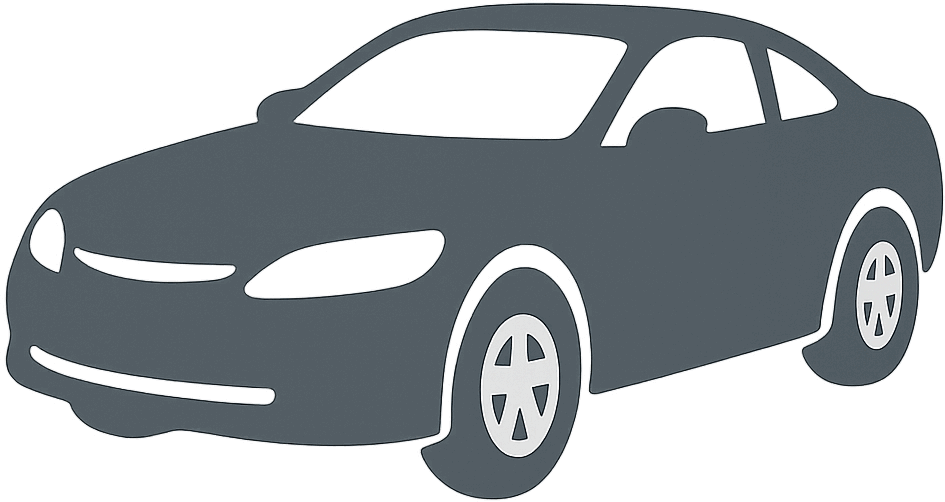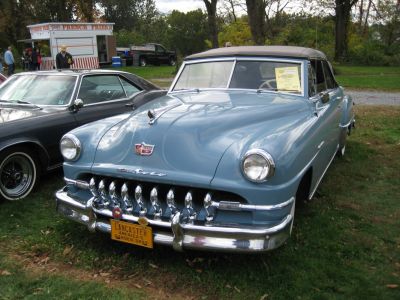 1952 DeSoto Firedome I Club Coupe Dimensions, Size & Specs
1952 DeSoto Firedome I Club Coupe Dimensions, Size & Specs
Measurements of the 1952 DeSoto Firedome I Club Coupe, engineered for optimal performance and comfort
| Dimensions | |
|---|---|
| Length: | 5293 mm208.4 in17.4 ft |
| Width: | 1902 mm74.9 in6.2 ft |
| Height: | 1667 mm65.6 in5.5 ft |
| Ground Clearance: | 229 mm9.0 in0.8 ft |
The 1952 DeSoto Firedome I Club Coupe represents a notable example of early 1950s American automotive design and engineering. Produced from 1951 to 1952, this coupe version of the Firedome I combined stylish, classic coupe aesthetics with substantial dimensions for its class at the time. With an overall length of 5293 mm (208.4 inches), it offers a spacious presence on the road, emphasizing both luxury and performance for a coupe. The width of 1902 mm (74.8 inches) gives the vehicle a broad stance, enhancing stability, while the height measures 1667 mm (65.6 inches), presenting a balanced profile typical for coupes of its era. Its ride height or ground clearance of 229 mm (9.0 inches) ensures sufficient clearance for varied road conditions, contributing to a comfortable and secure ride. The Firedome I Club Coupe is remembered for its robust design and substantial road presence, reflecting DeSoto's commitment to producing vehicles that combined attractive styling with practical dimensions. As a classic coupe from the early 1950s, it remains a significant reference point in automotive history for collectors and enthusiasts interested in vintage American cars. These detailed specifications help car enthusiasts and prospective buyers understand the Firedome I's size attributes, making it easier to compare with other vintage models and appreciate its distinctive build and road presence.
Discover the standout features that make the 1952 DeSoto Firedome I Club Coupe a leader in its class
Have a question? Please check our knowledgebase first.
The 1952 DeSoto Firedome I Club Coupe has a length of 5293 mm (208.4 inches), a width of 1902 mm (74.8 inches), and a height of 1667 mm (65.6 inches). These dimensions give the vehicle a substantial and classic presence typical of American coupes from the early 1950s, balancing spaciousness with a sleek coupe silhouette.
The 1952 DeSoto Firedome I Club Coupe features a ground clearance of 229 mm (9 inches). This relatively high ride height allows the vehicle to handle various road conditions common in the early 1950s, such as uneven surfaces and less developed pavements. It also helps protect the undercarriage from damage, contributing to better overall durability and ride comfort for its time.
With its length of 5293 mm (208.4 inches) and width of 1902 mm (74.8 inches), the 1952 DeSoto Firedome I Club Coupe is relatively large compared to modern compact cars. While it can fit into many standard residential garages, it may require careful maneuvering, especially in narrower garage spaces. Home garages built to accommodate mid-20th-century cars will generally be suitable.
At 1902 mm (74.8 inches) wide, the DeSoto Firedome I Club Coupe was considered wide in the early 1950s, contributing to its roomy interior and stable road presence. Many contemporaries averaged slightly narrower widths, often around 1800 mm (70.9 inches). The Firedome’s wide stance was part of the design strategy to emphasize comfort and style.
The 1952 Firedome I Club Coupe maintained a height of 1667 mm (65.6 inches), which was a slight evolution from its predecessor models produced prior to 1951. Earlier DeSoto coupes tended to be marginally taller or less aerodynamic, and the 1952 model improved styling with a slightly lower and sleeker roofline, helping modernize its overall look while still providing good headroom.
At 5293 mm (208.4 inches) in length, the Firedome I Club Coupe is quite a long vehicle by today's standards. This length provides generous passenger and trunk space but can also make parking and maneuvering in tight urban spaces more challenging. Drivers of this era typically had larger parking areas, but modern garages and parking lots might require more care to accommodate its size.
Compared to its predecessor, the 1952 DeSoto Firedome I Club Coupe is larger in both length and width, reflecting the 1950s trend toward bigger, more luxurious cars. The styling also evolved to include smoother lines and a more pronounced grille design, enhancing visual appeal. Its increased size translated into improved interior space and comfort, a key selling point over the previous generation.
The 1952 DeSoto Firedome I Club Coupe is generally larger than many of its American coupe contemporaries, such as the Chrysler New Yorker and Oldsmobile 88 coupes, which tended to be slightly shorter and narrower. This larger footprint contributed to a more spacious cabin and a commanding road presence, positioning it as a premium coupe option in the early 1950s market.
The 1952 Firedome I Club Coupe is recognized for its classic mid-century American design, incorporating a V8 HEMI engine, which was a technical highlight for performance and smooth operation. The coupe features a two-door design with stylish chrome accents, a spacious interior, and robust build quality. Its design balances elegance and power, appealing to buyers seeking both luxury and performance.
While exact weight figures vary slightly based on configuration, the Firedome I Club Coupe's relatively heavy build paired with a 229 mm (9 inches) ground clearance provides a solid and stable ride. The higher clearance supports driving over less smooth roads, while the car’s substantial weight helps it remain planted on the highway, contributing to comfort and confidence in handling during the 1950s.
Discover similar sized cars.

| Production: | 1951-1952 |
|---|---|
| Model Year: | 1951 |
| Length: | 5290 mm208.3 in |
| Width: | 1908 mm75.1 in |
| Height: | 1660 mm65.4 in |

| Production: | 1951-1952 |
|---|---|
| Model Year: | 1951 |
| Length: | 5290 mm208.3 in |
| Width: | 1908 mm75.1 in |
| Height: | 1660 mm65.4 in |

| Production: | 1951-1952 |
|---|---|
| Model Year: | 1951 |
| Length: | 5290 mm208.3 in |
| Width: | 1908 mm75.1 in |
| Height: | 1660 mm65.4 in |

| Production: | 1951-1952 |
|---|---|
| Model Year: | 1951 |
| Length: | 5290 mm208.3 in |
| Width: | 1908 mm75.1 in |
| Height: | 1660 mm65.4 in |

| Production: | 1951-1952 |
|---|---|
| Model Year: | 1952 |
| Length: | 5293 mm208.4 in |
| Width: | 1902 mm74.9 in |
| Height: | 1667 mm65.6 in |
